Laser communication in space, a solution for fast and secure communication
Is it possible to send data from a small satellite to Earth not by radio signals, but by laser light? That's the question the Dutch instrument SmallCAT is going to answer. SmallCAT is an innovative optical instrument developed by TNO and Hyperion that will fly on the Norwegian satellite NorSat-TD. The instrument was delivered at the end of May to be mounted on the satellite, with the launch scheduled for early 2023.
The main purpose of the satellite, which is being built on behalf of the Norwegian space agency NOSA, is monitoring of shipping traffic. It has been agreed between the Netherlands and Norway that SmallCat can fly with them to test the technology. Both countries are curious about the possibilities of laser communication, because radio frequencies are becoming scarcer and there is less bandwidth available. With the help of laser you can send more data at the same time. In addition, it is more difficult to eavesdrop on and therefore safer. The Dutch armed forces are also showing interest in this application.
Hyperion technologies, since 2020 part of the Swedish AAC Clyde Space, designed all the electronics and a large part of the software for SmallCAT. Bert Monna of Hyperion said, "SmallCAT is an incredibly complex system that uses state-of-the-art electronics and software. Based on our design and the tests we've done, we expect to send data from the satellite to Earth at a rate of 1 gigabit per second.'

Incredibly accurate
TNO did the system engineering of SmallCAT and created the optomechanical design. It also did the extensive testing and qualification of the instrument. Now that that's behind us, TNO and Hyperion, together with modem maker Celestia, are working on a ground station that will receive the data from SmallCAT.
'It will be a big challenge to capture laser beams from space,' says Erik Fritz of TNO. The narrower the laser beam, the more precisely you have to aim it at the ground station. We do this by sending a signal from Earth to SmallCAT, a kind of beacon. If the satellite keeps following that signal, it is automatically properly aligned to successfully send its data to Earth.'
The accuracy with which this alignment happens is almost unimaginable. 'We're talking about 100 microrad. That is a tiny angle, which is also created, for example, when you place a ruler on a flat surface, with a human hair underneath one of the ends. And then we've already included all the possible disturbances, such as thermal disturbance, sensor noise, control systems uncertainty, and mechanical misalignment.
ARTES program
The development of SmallCAT was c0-financed with NSO funds from the ESA ARTES program and by The Ministry of Defense from their innovation budget.This financial support is crucial, says Monna: 'In the coming years, the interest in laser communication will only increase. Initially between small satellites and earth, later possibly also between ships or between aircraft and the ground. If we can demonstrate now that we can deliver end-to-end solutions, we will be one of the frontrunners in this field. That offers great opportunities for Dutch industry in the future.'